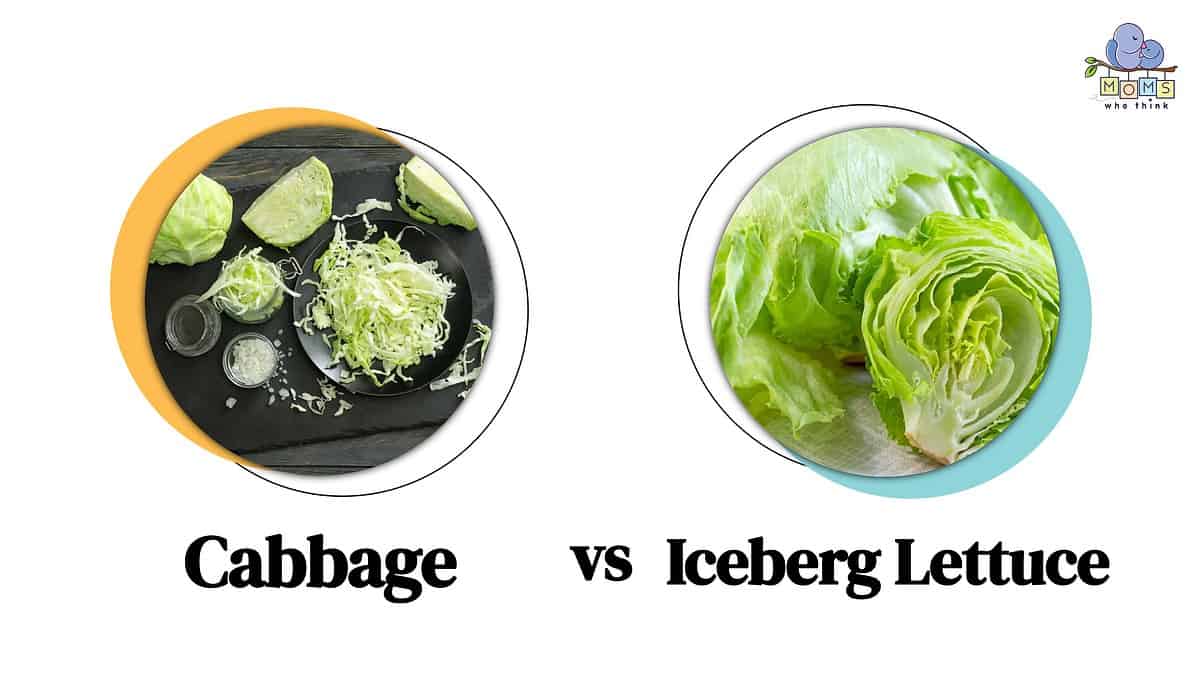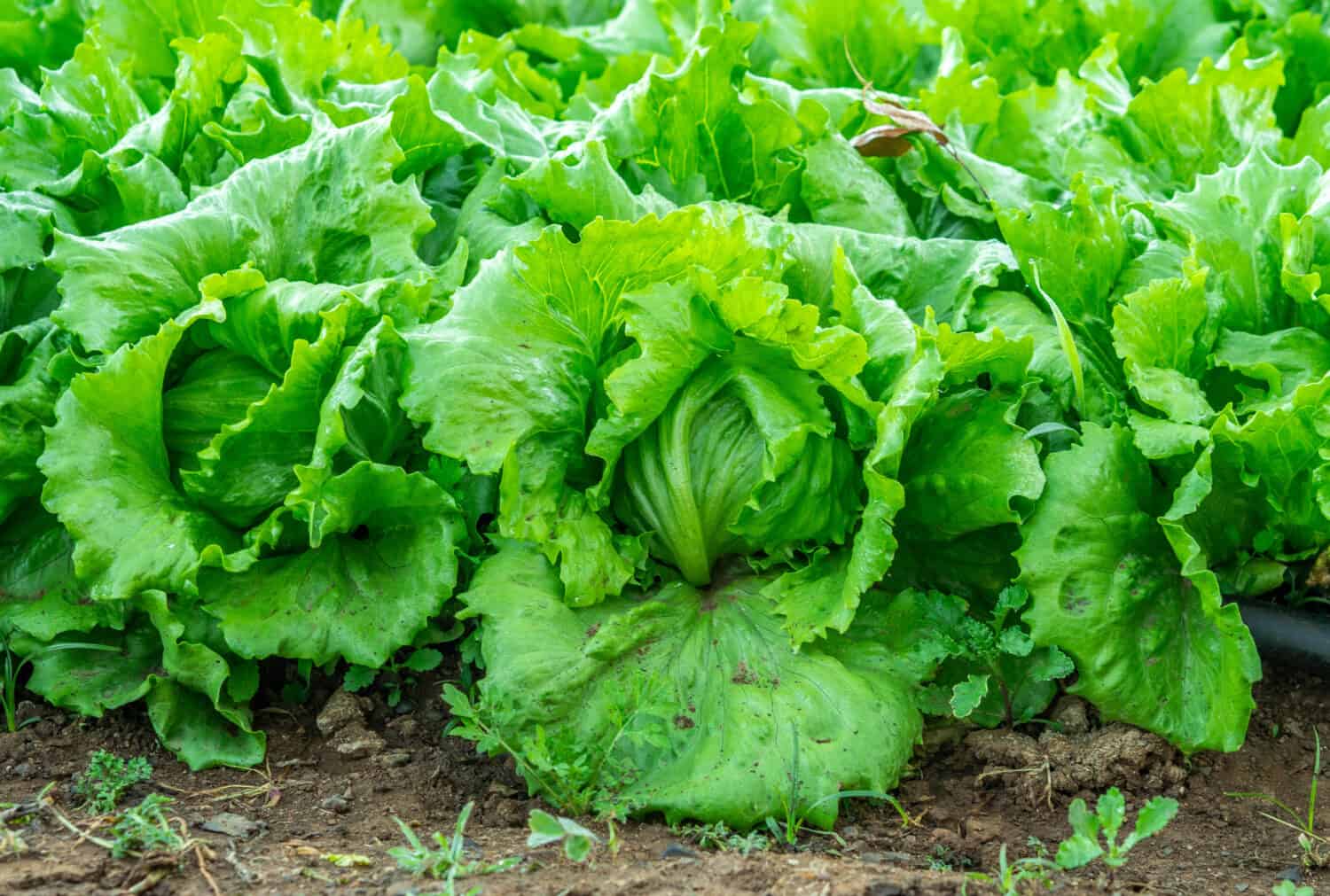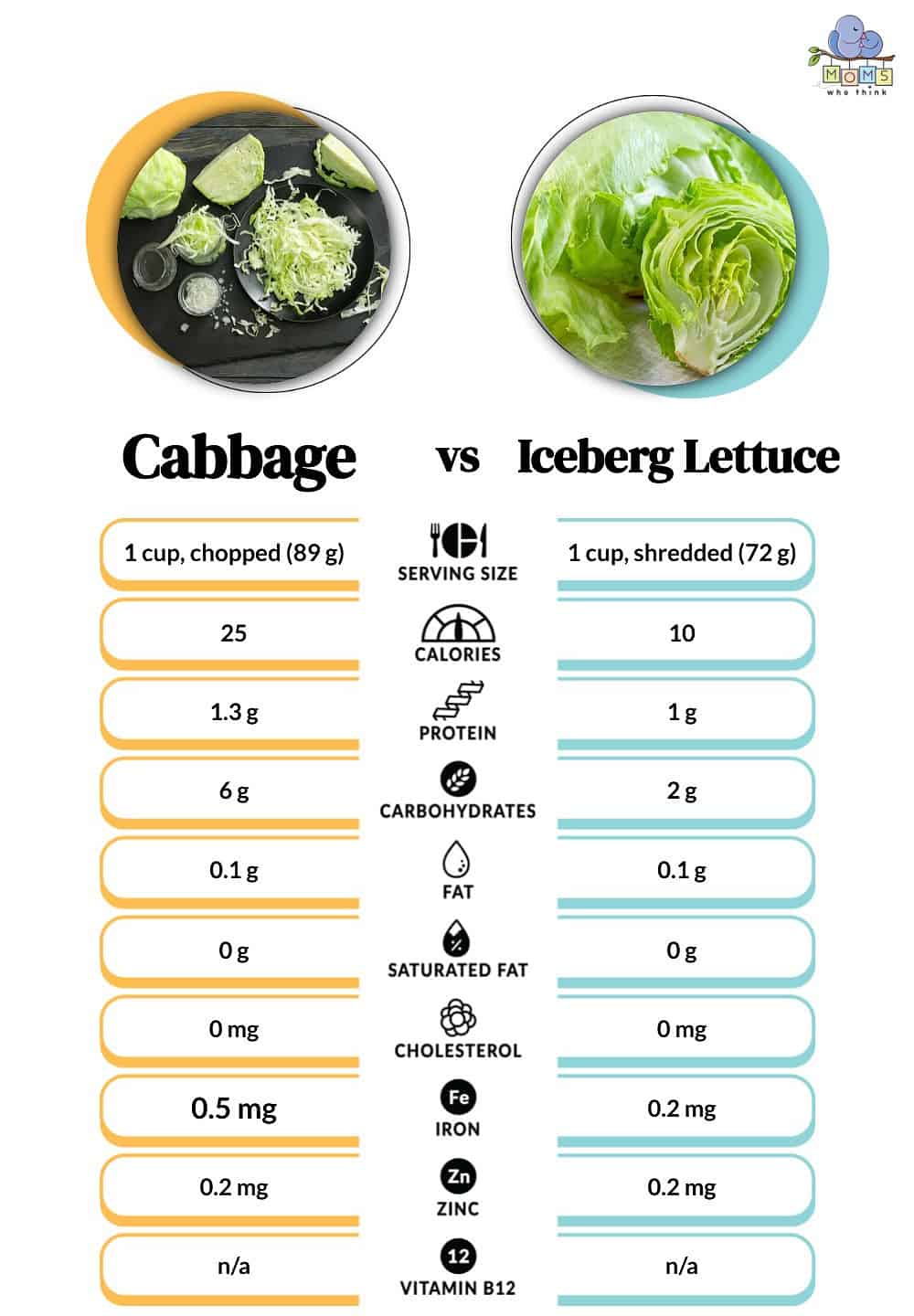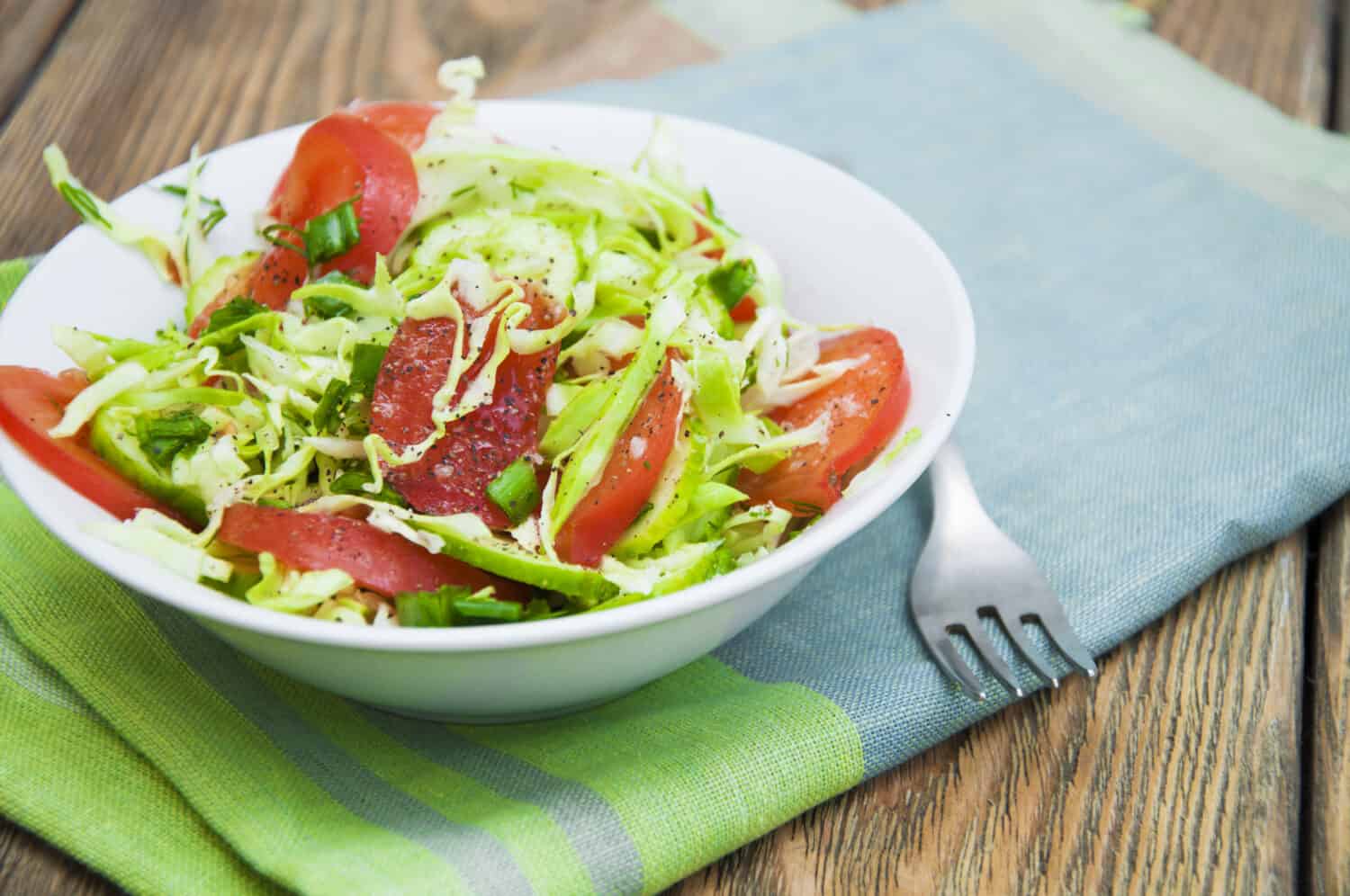When you push your cart down the produce aisle at your local grocery store, have you ever noticed all the different options in the leafy green section? What's up with all the lettuce and cabbage choices? Is one healthier than the other? Are all types of lettuce the same? And how is cabbage different?
While green cabbage and iceberg lettuce may appear similar, cabbage is a more nutritious option. But that's not all that sets these two leafy green vegetables apart.
From taste to texture and how they're used in the kitchen, there are many differences between cabbage and iceberg lettuce. Here's everything you need to know.

©
What is Cabbage?
While cabbage appears similar to lettuce, it's actually a cruciferous vegetable and part of the Brassicaceae family, similar to broccoli, kale, and cauliflower. This leafy vegetable can be grown in many different colors as well, including purple and red along with green. Additionally, there are variations like Chinese cabbage and savoy.
When spotting a cabbage at your grocery store, you'll notice that it's very round and has a short, almost nonexistent stem. It will also have a strong smell, and when prepared, it has a strong flavor. Cabbage can be used as a fresh ingredient in dishes like coleslaw, or it can be steamed and added to stew. Pickled cabbage is used to make sauerkraut and kimchi.
How to Choose Fresh Cabbage at the Store
The next time you shop for cabbage, be sure to look for a head that's firm and heavy when held. You'll also want to be sure the leaves are green without brown spots or blemishes. Cabbage is a biannual crop, so you'll find the freshest heads when it's in season between November and April.
What is Iceberg Lettuce?
Unlike cabbage, iceberg lettuce is not a cruciferous vegetable and instead belongs to the Asteraceae family. There are many different types of lettuce including romaine, which grows in long leaves, red leaf, and butterhead to name a few. Iceberg, however, is a common leafy lettuce that's round in shape.
Iceberg looks similar to cabbage in that both are sold as a “head” and have short stems, but iceberg has a lighter green color and its leaves aren't as tightly wrapped around the center. This lettuce is also a crunchy and healthy addition to salads, sandwiches, and wraps.
How to Choose Fresh Iceberg Lettuce at the Store
Look for a head of iceberg lettuce that's medium green in color. Also, be sure to check that the leaves aren't browning or wilting. Iceberg is an annual crop that's available year-round.
Cabbage vs. Iceberg Lettuce: What are the Differences?
As mentioned, cabbage and iceberg appear similar in the store when sitting next to each other. But the similarities end there. Here are five key differences between these two leafy vegetables:
Origin
Cabbage has a lengthy history as a cruciferous vegetable. According to Britannica, cabbage farming and production dates back to the European Middle Ages. Softer cabbages like Savoy are thought to have originated even before that.
Iceberg lettuce, on the other hand, has an intriguing history. While the exact origins of iceberg lettuce aren't clear, Produce Services of Los Angeles states that George Ballas, a horticulturist in California discovered this lettuce variation and coined its name in 1894. The name “iceberg” hailed from its crunchy texture and icey coloring. However, the name grew to include how the produce was shipped from California to the rest of the country in the 1920s. While the lettuce was growing in popularity, it was discovered that it could easily withstand shipment to various parts of the country by being placed in a refrigerated railcar packed with ice.

©Mario De Moya F/Shutterstock.com
Growth and Production
Both of these vegetables have differing origin stories because of the climate they grow in. Cabbage grows easier in cooler climates and struggles to withstand heat, while iceberg lettuce grows well in warmer climates. Additionally, cabbage is a biannual plant that is harvested twice a year. Lettuce is an annual plant that's only harvested once a year.
The Agricultural Marketing Resource Center also reports that cabbage production typically occurs in the fall, winter, and spring months in southern states of the U.S. Its production is extended into the summer in Northern states due to the cooler summer temps.
Taste
Take one bite of cabbage and you'll immediately notice it's different than iceberg lettuce! Cabbage is known for its strong and sharp, peppery flavoring while iceberg has a mild, almost bland flavor. This is due to the amount of water that's included in each vegetable. While both veggies have higher water content than many other foods, cabbage has less water content than iceberg lettuce.
Texture
Cabbage is known for its crunch. Whichever part of the head of cabbage you're consuming, the vegetable will be crunchy throughout. Iceberg, on the other hand, has a crunchy stem but softer leaves. This is also due to its higher water content.
Culinary Use
Because of its crunchy texture and strong flavor, cabbage can withstand different cooking methods. The vegetable can be steamed or boiled and is often pickled. The only time you may find cabbage raw is after it's shredded as a topping for salads or in coleslaw.
Iceberg lettuce, however, is softer in texture and therefore doesn't hold up to many cooking methods. It's typically consumed raw in a salad or as a topping for burgers and sandwiches.
Cabbage vs. Iceberg Lettuce: Nutritional Value
Both cabbage and iceberg lettuce are vegetables that are low in calories due to their water content. While they are both seen as healthy, low-calorie food items that are high in fiber, cabbage packs a punch nutritionally. Green cabbage is especially known for its high amounts of vitamins K and C.

©
Health Benefits of Cabbage and Iceberg Lettuce
Beyond being low in calories, both cabbage and iceberg lettuce are leafy greens that offer vitamins, antioxidants, and fiber. These nutrients can lead to several health benefits, including:
- Reduced inflammation. Antioxidants present in green vegetables can help to maintain inflammation and keep it from becoming a chronic problem.
- Improved digestion. High amounts of insoluble fiber found in these vegetables help to keep the digestive system healthy and functioning properly.
- Heart health. Cabbage and lettuce have essential nutrients that can help to reduce the risk of strokes and heart attacks. Additionally, their lower caloric intake leads to weight management, overall improving heart health.
Can You Substitute Cabbage with Iceberg Lettuce?
In certain situations, you can substitute cabbage with iceberg lettuce! Cabbage has a similar crunch and appearance to its leafy counterpart. Keep in mind, however, that it has a stronger flavor and can be tougher in texture. If you're using cabbage as a substitute for iceberg in a recipe, you may want to consider shredding and cooking it a bit before making the swap. You may want to use less cabbage than lettuce as well, due to cabbage's more pungent taste.
Best Substitutes for Cabbage
For best results, there are a few other veggies that may be a better substitute for green cabbage. These include:
- Brussels sprouts
- Bok Choy
- Kale
- Celery
- Other varieties of cabbage
Best Substitutes for Iceberg Lettuce
Iceberg is softer in texture and has a milder flavor. If you're in a pinch, try substituting it with these veggies instead:
- Leaf lettuce
- Spinach
- Romaine lettuce
- Kale
- Swiss chard
Cabbage vs. Iceberg Lettuce: Which One Will You Choose?
While these leafy green vegetables appear similar, they have many other differences including taste, texture, production, and how they're used in the kitchen. If you're looking to add cooked vegetables to your meal, give cabbage a try. If you're looking for a light and fresh, crispy crunch, on the other hand, iceberg may be a better fit. Whichever you choose, these vegetables will pack a punch in both nutrients and taste!
Tasty Cabbage Recipe
While cabbage does have a distinct taste, it has quite a few health benefits. To get those much-needed nutrients, try adding it to a dish for a well-balanced meal, like this one:
Print
Sausage, Potato, and Cabbage Stir-Fry
- Total Time: 30 minutes
Ingredients
- 1 pound bulk pork sausage
- 3 to 4 potatoes, peeled and cubed (about 3 cups)
- 4 carrots, sliced thin or diced (optional)
- 1/2 cup water
- Salt and pepper
- 6 cups coarsely chopped cabbage
Instructions
- Brown sausage in a large skillet. Drain off drippings.
- Add potatoes, carrots if you wish, and water to the meat in a skillet.
- Stir up the browned drippings from the bottom of the skillet and mix through the meat and vegetables.
- Cover and cook until vegetables are almost tender.
- Add cabbage and sprinkle with salt and pepper.
- Cover and cook for 5-8 minutes or until cabbage and potatoes are tender, stirring several times to prevent sticking.
- Prep Time: 15 minutes
- Cook Time: 15 minutes
- Category: Main Course
- Method: Stir-Frying
- Cuisine: Fusion
The image featured at the top of this post is ©Zb89V/Shutterstock.com.


